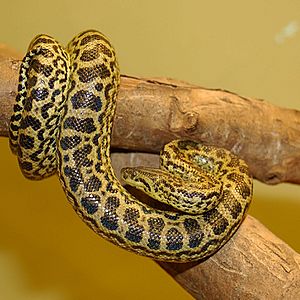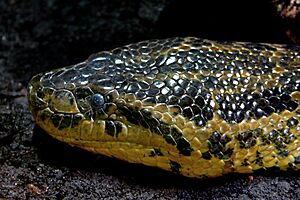Yellow anaconda facts for kids
Quick facts for kids Yellow anaconda |
|
|---|---|
 |
|
| Conservation status | |
| Scientific classification | |
| Genus: |
Eunectes
|
| Species: |
notaeus
|
| Synonyms | |
|
|
The yellow anaconda (Eunectes notaeus) is a large snake found only in southern South America. It is also known as the Paraguayan anaconda. This snake is a type of boa, which means it is not venomous. Like other boas, it catches its food by squeezing it tightly, a method called constriction. The yellow anaconda is one of the biggest snakes in the world, but it is smaller than its cousin, the green anaconda.
Contents
What Does a Yellow Anaconda Look Like?
Adult yellow anacondas usually grow to about 3.7 meters (12 feet) long. Female anacondas are generally bigger than males. Some females have been seen to be as long as 4.6 meters (15 feet)!
These snakes often weigh between 25 to 35 kilograms (55 to 77 pounds). However, some very large ones have weighed over 55 kilograms (121 pounds).
Their skin color is usually yellow, golden-tan, or greenish-yellow. They have a pattern of black or dark brown shapes like saddles, blotches, spots, and streaks all over their body.
Where Do Yellow Anacondas Live?
Yellow anacondas live in the areas around the Paraguay River and its smaller rivers. This includes the Pantanal region in Bolivia, Paraguay, and western Brazil. You can also find them in northeastern Argentina and northern Uruguay.
They love places with lots of water, like swamps, marshes, and the bushy banks of slow-moving rivers and streams. There have been reports of yellow anacondas in Florida, likely from pets that escaped. However, it is not known if these snakes are having babies there.
Some scientists now think that two other types of anacondas, Eunectes beniensis and Eunectes deschauenseei, are actually the same as the yellow anaconda. If this is true, then yellow anacondas would also be found in western Bolivia, northern Brazil, and coastal French Guiana.
How Do Yellow Anacondas Live and Hunt?
Yellow anacondas mostly hunt for food in the shallow waters of wetlands. They hunt most often from June to November. This is when the water levels are lower, and wading birds are easier to catch.
Scientists have studied what these snakes eat by looking at their stomach contents and waste. They found that yellow anacondas eat many different kinds of animals. They use two main ways to hunt:
- Ambush hunting: They hide and wait for prey to come close.
- Wide-foraging: They actively search for food.
Their diet is almost entirely made up of animals that live in or near water. This includes many types of mammals, birds, reptiles, amphibians, fish, and even eggs. Bigger anacondas can catch larger animals like small deer, capybaras (large rodents), or peccaries (pig-like animals). Sometimes, yellow anacondas even eat other yellow anacondas!
Who Hunts the Yellow Anaconda?
Yellow anacondas do not have many animals that hunt them. Young anacondas and sometimes even adult ones can be eaten by caimans (like alligators), bigger anacondas, jaguars, cougars, and some wild dogs like the crab-eating fox. Other predators include weasels and large birds of prey. Sadly, humans also hunt these snakes for their skin.
Yellow Anacondas and People
When yellow anacondas are kept in zoos or as pets, especially if they were caught from the wild, they can be a bit unpredictable. This has led some animal experts to try and breed them in captivity.
In the United States, it became illegal in 2012 to bring, move, or sell yellow anacondas across state lines. This rule was put in place to stop them from becoming an invasive species in places like the Florida Everglades. An invasive species is an animal that is not native to an area and can harm the local environment.
Scientists have not yet fully studied the yellow anaconda's conservation status. This means they haven't officially decided if the snake is endangered or at risk.
See also
 In Spanish: Anaconda amarilla para niños
In Spanish: Anaconda amarilla para niños





